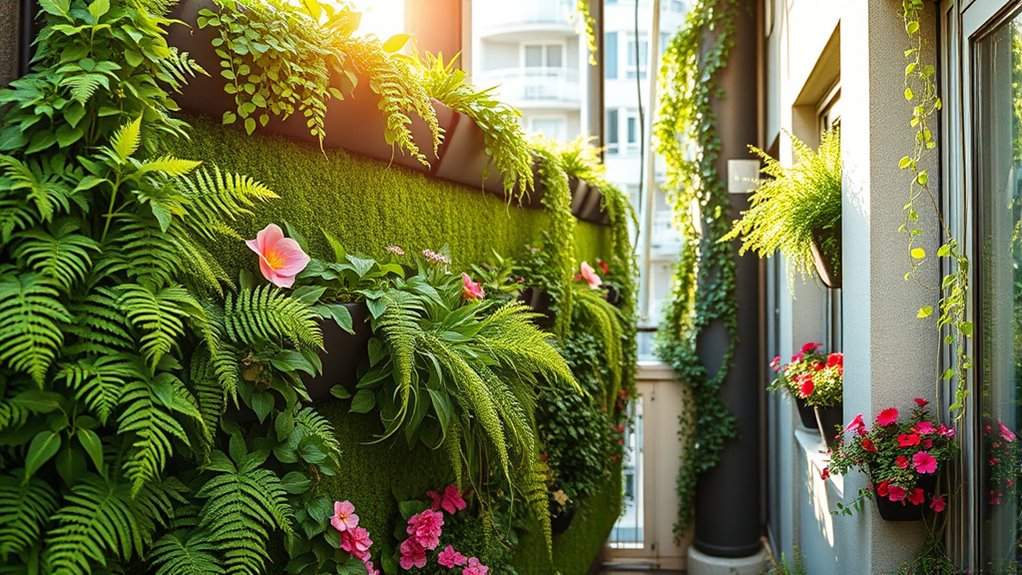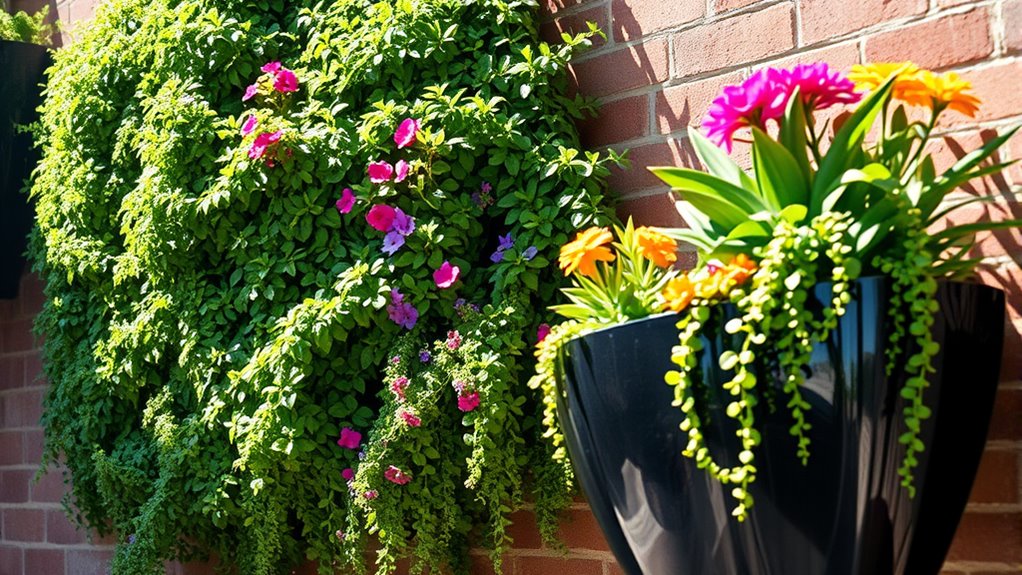Vertical gardening lets you maximize small spaces by transforming walls or fences into vibrant green displays. You can choose easy-care plants like succulents, herbs, and trailing varieties suited for limited spots. By engaging neighbors or friends in planting and maintenance, you’ll foster community pride and create inviting shared areas. With thoughtful plant selection and design, you turn a tiny corner into a lush sanctuary. Keep exploring for tips on creating your own thriving vertical garden.
Key Takeaways
- Maximize limited space by creating lush, vertical gardens with plants like succulents, herbs, and trailing varieties.
- Engage community members through planting workshops and shared maintenance to foster ownership and sustainability.
- Select low-maintenance, space-efficient plants suited to sunlight exposure for easier care and thriving growth.
- Design visually appealing layouts using diverse textures, colors, and plant heights to enhance aesthetic interest.
- Transform small areas into social, green sanctuaries that promote environmental awareness and community connection.

Have you ever wondered how to maximize limited space while creating a lush, green oasis? Vertical gardening offers a perfect solution, transforming small areas into vibrant, living displays. When you delve into this approach, you’re not just planting; you’re creating a community hub that encourages interaction and shared appreciation for greenery. By involving neighbors or local groups, you foster community engagement, making your vertical garden more than just a visual feature—it’s a social space that brings people together around a common love for nature.
Choosing the right plant selection is vital in vertical gardening, especially when space is tight. Opt for plants that thrive in confined environments and can grow vertically without sprawling excessively. Succulents, herbs, ferns, and trailing plants like pothos or ivy work well because they adapt easily and require minimal space. Consider the sunlight your area receives and choose plants accordingly—shade-loving varieties for shaded spots and sun-loving ones for sunnier walls. The right plant choices will not only guarantee your garden thrives but also make maintenance easier, saving you time and effort.
Choose low-maintenance, space-efficient plants like succulents, herbs, and trailing varieties for thriving vertical gardens.
Community engagement plays a key role in the success of your vertical garden. When you involve others, whether it’s neighbors, friends, or local organizations, you create a shared sense of ownership and pride. You might organize planting days or workshops, which not only help with the physical work but also build relationships and knowledge sharing. As more people become invested, your garden becomes a communal asset, fostering a sense of belonging and environmentally conscious behavior. Additionally, community involvement can lead to donations of plants or materials, making your vertical garden more sustainable and budget-friendly.
Plant selection should also consider the aesthetic and functional aspects of your space. Use a variety of textures, colors, and heights to add visual interest. Incorporate flowering plants for bursts of color, or choose aromatic herbs to make your garden both beautiful and useful. Think about watering needs and maintenance levels—group plants with similar needs together for easier care. Vertical gardens are dynamic, so regularly rotating or updating plants can keep the space lively and engaging for everyone involved.
In essence, creating a vertical garden in a small space is about more than just planting—it’s about building a community and making thoughtful plant choices that guarantee your green space flourishes. When you focus on engaging others and selecting the right plants, you turn a tiny patch into a thriving, shared sanctuary that enhances your environment and brings people closer to nature.
Frequently Asked Questions
What Are the Best Plants for Vertical Gardens in Shaded Areas?
When choosing plants for shaded areas, you want shade tolerant plants that thrive with low light greenery. You might consider ferns, pothos, or snake plants, as they adapt well to low light conditions and add lush texture. These plants require minimal maintenance and can brighten up your space without direct sun. By selecting the right shade-tolerant plants, you’ll create a vibrant, thriving vertical garden even in darker spots.
How Do I Prevent Pests in My Vertical Garden?
You can prevent pests in your vertical garden by using natural repellents like neem oil or introducing companion plants such as marigolds, which deter harmful insects. Regularly check your plants for signs of pests and remove any affected leaves promptly. Combining companion planting with natural repellents creates a healthy environment, reducing pests without chemicals. This approach keeps your garden thriving and pest-free, ensuring lush, vibrant greenery.
What Is the Ideal Watering Schedule for Vertical Gardens?
You might think watering is complicated, but it’s simple once you understand your plants’ needs. For ideal growth, check moisture levels regularly and water when the top inch feels dry. Typically, watering frequency varies by plant type and environment, but most vertical gardens thrive with once or twice a week. Avoid overwatering to prevent root rot, and always guarantee good drainage to keep moisture levels balanced.
Can Vertical Gardens Be Built Indoors? What Are the Requirements?
Yes, you can build vertical gardens indoors. To succeed, guarantee your space has adequate indoor lighting, like grow lights or near windows, to support plant growth. Focus on a good vertical garden design that fits your space and plant needs. You’ll also need a reliable watering system and proper ventilation. With the right setup, indoor vertical gardens thrive, adding greenery and fresh air to your home.
How Do I Maintain Soil Fertility in a Vertical Planting System?
Ever wonder how to keep your vertical garden thriving? The secret lies in maintaining soil fertility, and it all starts with monitoring your soil nutrients closely. Incorporate composting techniques regularly to replenish essential nutrients naturally. This simple yet powerful habit ensures your plants get the nourishment they need, keeps the soil healthy, and guarantees lush, vibrant growth. Stay attentive, and your vertical garden will flourish against all odds.
Conclusion
Now that you’ve discovered how vertical gardening transforms small spaces into lush, green escapes, it’s like planting a piece of paradise right on your wall. With a little creativity and effort, you can turn even the tiniest corner into a vibrant oasis. Think of your wall as a blank canvas waiting for nature’s brushstrokes. So, go ahead—bring life to your space and watch your urban jungle flourish beyond your wildest dreams.









